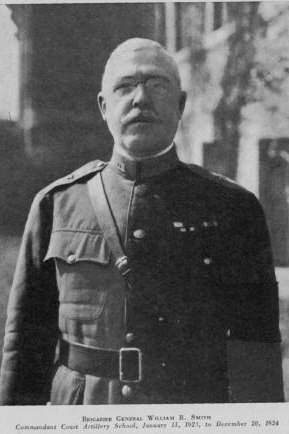William Ruthven Smith facts for kids
Quick facts for kids
William Ruthven Smith
|
|
|---|---|
 |
|
| Born | April 2, 1868 Nashville, Tennessee |
| Died | July 15, 1941 (aged 73) Sewanee, Tennessee |
| Allegiance | |
| Service/ |
|
| Years of service | 1892 - 1932 |
| Rank | |
| Commands held | Superintendent of the United States Military Academy |
| Awards | Distinguished Service Medal |
William Ruthven Smith (born April 2, 1868 – died July 15, 1941) was an important officer in the United States Army. He led soldiers in World War I and later became the head of the famous West Point school.
Contents
Early Life and Education
William Ruthven Smith was born in Nashville, Tennessee, on April 2, 1868. His parents were Robert McPhail and Lititia (Trimble) Smith. Young William went to Vanderbilt University.
Later, he was chosen to attend the United States Military Academy. This is a top school for training army officers. He graduated in 1892, ranking 10th out of 62 students in his class.
Military Career
After graduating, Smith served in the army for many years. He worked in field artillery, which uses large guns. He also taught subjects like chemistry and math at West Point.
Early Commands
In 1901, he became a captain in the new Coast Artillery Corps. This group protected coastlines from attacks. He studied how to defend against submarines and commanded Fort Monroe in 1908.
Before World War I, Smith led schools that focused on anti-submarine technology. In early 1917, he helped set up a very long submarine net. This net stretched across the entrance to Hampton Roads in Virginia.
World War I Service
In May 1917, Smith was promoted to colonel. He then became a brigadier general in the National Army. His job was to train the 62nd Field Artillery Brigade. He trained these soldiers for nine months in Alabama.
In the summer of 1918, Smith was given command of the 36th Infantry Division. He was also promoted to major general. His division traveled to Brest, France, to join the war.
In France, General Smith set up a special training course for his soldiers. In October 1918, he led the 36th Division. They worked with the French Fourth Army and pushed towards the Aisne River. After the war ended, Smith oversaw the division's return home. In June 1919, his rank went back to colonel.
Post-War Assignments
Later, Smith was promoted back to brigadier general in the regular army. He served in several places, including the Philippines, Fort Sam Houston, and Honolulu, Hawaii.
From 1928 to 1932, he returned to West Point as its superintendent. During his time there, he helped get Stewart Field for the Army Air Corps. This field was used for training pilots from West Point.
Civilian Life and Legacy
After retiring from the army, General Smith moved back to Sewanee, his home state. He became the superintendent of the local military academy, which is now called St. Andrew's-Sewanee School. He held this position until he passed away.
William Ruthven Smith died on July 15, 1941, in West Point, New York. A place called Battery Smith at Fort Miles in Delaware was named after him. This battery had two very large 16-inch guns.

